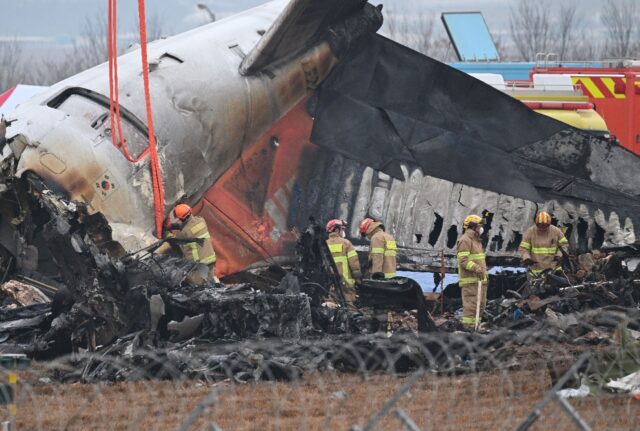South Korean investigators probing a Jeju Air crash which killed 179 people in the worst aviation disaster on its soil said Wednesday they will send one of the retrieved black boxes to the United States for analysis.
The Boeing 737-800 was carrying 181 people from Thailand to South Korea Sunday when it issued a mayday call and belly-landed before hitting a barrier and bursting into flames, killing everyone aboard except two flight attendants pulled from the burning wreckage.
South Korean and US investigators, including from Boeing, have been combing the crash site in southwestern Muan since the disaster to establish a cause.
“The damaged flight data recorder has been deemed unrecoverable for data extraction domestically,” said South Korea’s deputy minister for civil aviation, Joo Jong-wan.
“It was agreed today to transport it to the United States for analysis in collaboration with the US National Transportation Safety Board.”
Joo earlier said both of the plane’s black boxes were retrieved, and for the cockpit voice recorder “the initial extraction has already been completed”.
“Based on this preliminary data, we plan to start converting it into audio format,” he said, meaning investigators would be able to hear the pilots’ final communications.
The second black box, the flight data recorder, “was found with a missing connector”, Joo said.
Officials initially pointed to a bird strike as a possible cause of the disaster, but they have since said the probe was also examining a concrete barrier at the end of the runway, which dramatic video showed the plane colliding with before bursting into flames.
A special inspection of all Boeing 737-800 models operated by local carriers was examining their landing gear after it “failed to deploy” in this case, said the director general for aviation safety policy, Yoo Kyeong-soo.
Local media reported the landing gear had deployed properly on Jeju Air Flight 2216’s first failed landing attempt at Muan airport before failing on the second.
The issue “will likely be examined by the Accident Investigation Board” through a review of testimony and evidence, the ministry of land, which oversees civil aviation, said at a briefing.
– All victims identified –
At Muan airport, relatives of the victims were allowed to visit the site on Wednesday for the first time since the crash.
Families were taken to see the runway and the cement wall that the plane hit, according to the ministry of land.
Hundreds of people also queued up to pay their respects at a memorial altar set up to honour the victims.
So many people came to the memorial that the queue stretched for hundreds of metres and the local cell phone network was overloaded, local media reported.
Other altars for the victims have been set up nationwide.
Officials have said the bodies were extensively damaged by the crash, making the work of identifying remains slow and immensely difficult, while investigators had to preserve crash-site evidence.
But the country’s acting president Choi Sang-mok, who has been in office less than a week, said Wednesday the process had finally been completed, and that more bodies had been handed over to relatives so that they could hold funerals.
“Our investigators, along with the US National Transportation Safety Board and the manufacturer, are conducting a joint investigation into the cause of the accident,” Choi said at a disaster response meeting.
“A comprehensive analysis and review of the aircraft’s structure and the black box data will reveal the cause of the accident,” Choi added.
US investigators arrived Monday and headed straight to Muan, with the initial on-site joint probe focusing on a navigation system known as a localiser that assists in aircraft landings and was blamed for exacerbating the crash’s severity.
The plane was largely carrying holidaymakers back from year-end trips to Bangkok, with all passengers Korean nationals except for two Thais.

COMMENTS
Please let us know if you're having issues with commenting.